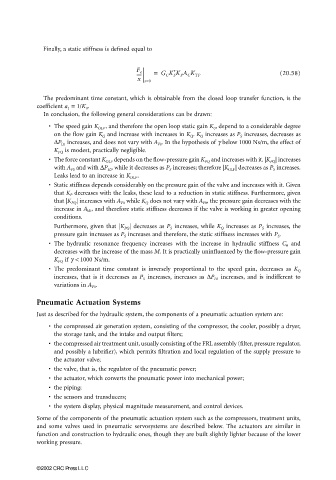Page 613 - The Mechatronics Handbook
P. 613
0066_Frame_C20 Page 83 Wednesday, January 9, 2002 5:49 PM
Finally, a static stiffness is defined equal to
F e = (20.58)
---- G C K S ′K P A C K TP
x s=0
The predominant time constant, which is obtainable from the closed loop transfer function, is the
coefficient a 1 = 1/K 0 .
In conclusion, the following general considerations can be drawn:
• The speed gain K OLV , and therefore the open loop static gain K 0 , depend to a considerable degree
on the flow gain K Q and increase with increases in K Q . K Q increases as P S increases, decreases as
∆P L0 increases, and does not vary with A V0 . In the hypothesis of γ below 1000 Ns/m, the effect of
K PQ is modest, practically negligible.
• The force constant K OLF depends on the flow-pressure gain K PQ and increases with it. |K PQ | increases
with A V0 and with ∆P L0 , while it decreases as P S increases; therefore |K OLF | decreases as P S increases.
Leaks lead to an increase in K OLF .
• Static stiffness depends considerably on the pressure gain of the valve and increases with it. Given
that K P decreases with the leaks, these lead to a reduction in static stiffness. Furthermore, given
that |K PQ | increases with A V0 while K Q does not vary with A V0 , the pressure gain decreases with the
increase in A V0 , and therefore static stiffness decreases if the valve is working in greater opening
conditions.
Furthermore, given that |K PQ | decreases as P S increases, while K Q increases as P S increases, the
pressure gain increases as P S increases and therefore, the static stiffness increases with P S .
• The hydraulic resonance frequency increases with the increase in hydraulic stiffness C 0 and
decreases with the increase of the mass M. It is practically uninfluenced by the flow-pressure gain
K PQ if γ < 1000 Ns/m.
• The predominant time constant is inversely proportional to the speed gain, decreases as K Q
increases, that is it decreases as P S increases, increases as ∆P L0 increases, and is indifferent to
variations in A V0 .
Pneumatic Actuation Systems
Just as described for the hydraulic system, the components of a pneumatic actuation system are:
• the compressed air generation system, consisting of the compressor, the cooler, possibly a dryer,
the storage tank, and the intake and output filters;
• the compressed air treatment unit, usually consisting of the FRL assembly (filter, pressure regulator,
and possibly a lubrifier), which permits filtration and local regulation of the supply pressure to
the actuator valve;
• the valve, that is, the regulator of the pneumatic power;
• the actuator, which converts the pneumatic power into mechanical power;
• the piping;
• the sensors and transducers;
• the system display, physical magnitude measurement, and control devices.
Some of the components of the pneumatic actuation system such as the compressors, treatment units,
and some valves used in pneumatic servosystems are described below. The actuators are similar in
function and construction to hydraulic ones, though they are built slightly lighter because of the lower
working pressure.
©2002 CRC Press LLC

